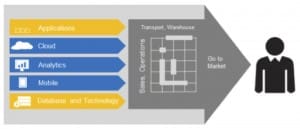Ok, there is not just one challenge that logistics service providers face, or one that stands out among the rest either. Logistics service providers (LSPs) face the same challenges that have been on their plate for a number of years now. Therefore, I see the main challenge as “laundry list” management, at least for the foreseeable future.
For big monolithic challenges, you have to look out one or two decades, at things like urbanization, smart cities, nanotechnology, and a possible new transport mode: space transport. Yep, I meant to write that. SpaceX has just begun to scratch the surface here, so a new mode is a good two decades or more away, but it is coming, even in my lifetime and I am “really-old” according to my 8-year-old. Not that a big paradigm shift won’t come sooner, I just don’t see something occurring in the near term, say 1 to 3 years out (maybe in-memory computing depending on the adoption rate by LSPs and small and midsize enterprises).
So let’s consider some more current challenges. Here are some areas that are not really pressed for further improvement at the moment, so I don’t view them as standout challenges:
- Capacity forecasts
- In-network inventory management
- Alignment of manufacturing and logistics
- Systems integration
- Information sharing
The only noteworthy challenge I see here is the need to collaborate better within these areas, but each of these areas have seen reasonable improvement or steady alignment with expectation, especially from the top-performers, in recent years.
Let’s also consider some of the areas that could use some improvement:
- Invoicing
- Cash-to-cash cycles
- Days of sales in inventory
- Visibility
- Collaboration
- Differentiated services
- Strategic partnering
Looking at the details for these would reveal that visibility and collaboration improvements would help alleviate most of these other pain-points and, if I were to expand on each of these, we would still end up with a laundry list of items that would not really surprise anyone, i.e., no real standout challenges.
So, what do we do until space transport from a fully automated smart city of 50 million people comes around? Well, we do the laundry.
My suggestion is to reconsider how to air your dirty laundry. Take a look at your laundry list against a framework for process improvement or technology requirements. Since I come from the technology side, I will offer this as an optional starting point: Create a matrix (keep it simple) that lists your top 3-5 business drivers as column headings and lists Business Applications, Analytics, Mobility, Cloud, and Integration Technologies as row titles. Then air that dirty laundry by listing it in the body of the matrix at the most appropriate intersection.

Now, set the dial: Heavy Soil, Permanent Press, Extended Spin, etc. depending on your circumstances and make some decisions (yes, I did look at my washing machine’s control panel to create this analogy). Where you see clustering is where you should consider making investments. You can also turn this around and point it outside directly at your market and it will help you formulate a plan to take your services to that market (see graphic below).

The bottom line comes down to making your services relevant, scalable and profitable. This involves processes and technology analysis, so you will need to address the process part to achieve a responsible framework. I guess I just gave myself an assignment for my next guest commentary; now I just have to figure out how to create a fluff-n-fold analogy for process improvement.
Bob Leeds is an Industry Marketing Director at SAP responsible for go-to-market plans and industry analysis for multiple global software solutions for the transportation and logistics industry. He has over 17 years of operations management, business development, and marketing experience with information technology and logistics companies. Prior to SAP, Bob held various positions at Verizon, DecisionOne, Servigistics, and Kewill.
















